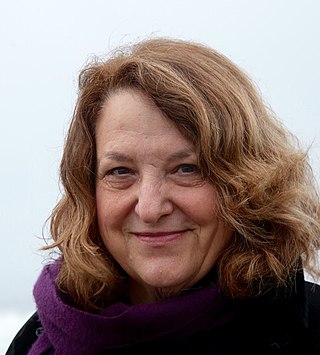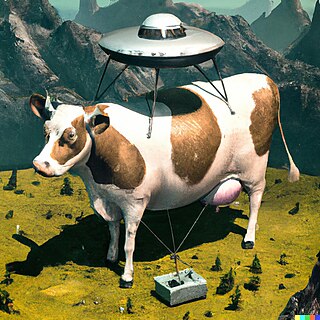Related Research Articles

Artificial intelligence (AI) is the intelligence of machines or software, as opposed to the intelligence of humans or animals. It is also the field of study in computer science that develops and studies intelligent machines. "AI" may also refer to the machines themselves.
In the field of artificial intelligence, the most difficult problems are informally known as AI-complete or AI-hard, implying that the difficulty of these computational problems, assuming intelligence is computational, is equivalent to that of solving the central artificial intelligence problem—making computers as intelligent as people, or strong AI. To call a problem AI-complete reflects an attitude that it would not be solved by a simple specific algorithm.

Digital art refers to any artistic work or practice that uses digital technology as part of the creative or presentation process. It can also refer to computational art that uses and engages with digital media.

An AI takeover is a hypothetical scenario in which artificial intelligence (AI) becomes the dominant form of intelligence on Earth, as computer programs or robots effectively take control of the planet away from the human species. Possible scenarios include replacement of the entire human workforce, takeover by a superintelligent AI, and the popular notion of a robot uprising. Stories of AI takeovers are very popular throughout science fiction. Some public figures, such as Stephen Hawking and Elon Musk, have advocated research into precautionary measures to ensure future superintelligent machines remain under human control.

The following outline is provided as an overview of and topical guide to artificial intelligence:

Lynn Hershman Leeson is a multimedia American artist and filmmaker. Her work combines art with social commentary, particularly on the relationship between people and technology. Leeson is a pioneer in new media, and her work with technology and in media-based practices helped legitimize digital art forms. Her interests include feminism, race, surveillance, and artificial intelligence and identity theft through algorithms and data tracking. She has been referred to as a "new media pioneer" for the prescient incorporation of new science and technologies in her work. She is based in San Francisco, California.

The ethics of artificial intelligence is the branch of the ethics of technology specific to artificially intelligent systems. It is sometimes divided into a concern with the moral behavior of humans as they design, make, use and treat artificially intelligent systems, and a concern with the behavior of machines, in machine ethics.
Digital immortality is the hypothetical concept of storing a person's personality in digital substrate, i.e., a computer, robot or cyberspace. The result might look like an avatar behaving, reacting, and thinking like a person on the basis of that person's digital archive. After the death of the individual, this avatar could remain static or continue to learn and self-improve autonomously.
BINA48 is a robotic face combined with chatbot functionalities, enabling simple conversation facilities. BINA48 is owned by Martine Rothblatt's Terasem Movement. It was developed by Hanson Robotics and released in 2010. Its physical appearance is modeled after Bina Aspen, Rothblatt's wife.
Deana Lawson (1979) is an American artist, educator, and photographer based in Brooklyn, New York. Her work is primarily concerned with intimacy, family, spirituality, sexuality, and Black aesthetics.
Hanson Robotics Limited is a Hong Kong-based engineering and robotics company founded by David Hanson, known for its development of human-like robots with artificial intelligence (AI) for consumer, entertainment, service, healthcare, and research applications. The robots include Albert HUBO, the first walking robot with human-like expressions; BINA48, an interactive humanoid robot bust; and Sophia, the world's first robot citizen. The company has 45 employees.

Mario Klingemann is a German artist best known for his work involving neural networks, code, and algorithms. Klingemann was a Google Arts and Culture resident from 2016 to 2018, and he is considered as a pioneer in the use of computer learning in the arts. His works examine creativity, culture, and perception through machine learning and artificial intelligence, and have appeared at the Ars Electronica Festival, the Museum of Modern Art New York, the Metropolitan Museum of Art New York, the Photographers’ Gallery London, the Centre Pompidou Paris, and the British Library. Today he lives in Munich, where, in addition to his art under the name "Dog & Pony", he still runs a creative free space between gallery and Wunderkammer with the paper artist Alexandra Lukaschewitz.

Joëlle Pineau is a Canadian computer scientist and associate professor at McGill University. She is the lead of Facebook's Artificial Intelligence Research lab (FAIR) in Montreal, Quebec.

Artificial intelligence art is any visual artwork created through the use of artificial intelligence (AI) programs.

Ai-Da is "the world's first ultra-realistic humanoid robot". Completed in 2019, Ai-Da is an android incorporating computer graphics and artificial intelligence algorithms that makes drawings, paintings, and sculptures. She is named after Ada Lovelace.
Regulation of algorithms, or algorithmic regulation, is the creation of laws, rules and public sector policies for promotion and regulation of algorithms, particularly in artificial intelligence and machine learning. For the subset of AI algorithms, the term regulation of artificial intelligence is used. The regulatory and policy landscape for artificial intelligence (AI) is an emerging issue in jurisdictions globally, including in the European Union. Regulation of AI is considered necessary to both encourage AI and manage associated risks, but challenging. Another emerging topic is the regulation of blockchain algorithms and is mentioned along with regulation of AI algorithms. Many countries have enacted regulations of high frequency trades, which is shifting due to technological progress into the realm of AI algorithms.
The regulation of artificial intelligence is the development of public sector policies and laws for promoting and regulating artificial intelligence (AI); it is therefore related to the broader regulation of algorithms. The regulatory and policy landscape for AI is an emerging issue in jurisdictions globally, including in the European Union and in supra-national bodies like the IEEE, OECD and others. Since 2016, a wave of AI ethics guidelines have been published in order to maintain social control over the technology. Regulation is considered necessary to both encourage AI and manage associated risks. In addition to regulation, AI-deploying organizations need to play a central role in creating and deploying trustworthy AI in line with the principles of trustworthy AI, and take accountability to mitigate the risks. Regulation of AI through mechanisms such as review boards can also be seen as social means to approach the AI control problem.
VITAL was a Board Management Software machine learning proprietary software developed by Aging Analytics, a company registered in Bristol (England) and dissolved in 2017. Andrew Garazha declared that the project aimed "through iterative releases and updates to create a piece of software capable of making autonomous investment decisions." According to Nick Dyer-Witheford, VITAL 1.0 was a "basic algorithm".

Jake Elwes is a British media artist. Their practice is the exploration of artificial intelligence (AI), queer theory and technical biases. They are known for using AI to create art in mediums such as video, performance and installation. Their work on queering technology addresses issues caused by the normative biases of artificial intelligence.
References
- ↑ Hellmann, Melissa (2 August 2019). "Artist works to merge artificial intelligence and art". The Seattle Times. Retrieved 3 May 2020.
- ↑ Dinkins, Stephanie (2018-10-19). "Five Artificial Intelligence Insiders in Their Own Words". The New York Times. ISSN 0362-4331 . Retrieved 2020-02-21.
- 1 2 Pardes, Arielle (23 October 2018). "The Case for Giving Robots an Identity". Wired. ISSN 1059-1028 . Retrieved 2020-02-25.
- ↑ Dinkins, Stephanie (2017-11-29). "Meet Stephanie Dinkins". Eyebeam. Retrieved 2019-12-09.
- ↑ Dooley, Tatum (2019-08-15). "Stephanie Dinkins Is Turning Memoir Into AI". VICE. Retrieved 2020-02-25.
- ↑ Brett, Wallace (December 21, 2018). "A Conversation With Stephanie Dinkins". Conversation Project NYC. Retrieved 2020-05-03.
- ↑ Building Equitable AI, 2018-10-24, retrieved 2021-03-31
- ↑ "Stephanie Dinkins". A Blade of Grass. Retrieved 2021-03-31.
- ↑ "Stephanie Dinkins". Data & Society. Retrieved 2020-02-21.
- ↑ "Stephanie Dinkins". Stony Brook University | Department of art. 2012-11-20. Retrieved 2020-05-02.
- ↑ "Stephanie Dinkins". Stonybrook University Department of Art. Retrieved 2020-02-21.
- ↑ Cizek, Katerina; Uricchio, William; Wolozin, Sarah (2019-06-03), "Part 6: Media Co-Creation with Non-Human Systems", Collective Wisdom, MIT Press, retrieved 2020-02-25
- ↑ "Robots, Race, and Algorithms: Stephanie Dinkins at Recess Assembly". Art21 Magazine. 7 November 2017. Retrieved 2020-02-25.
- ↑ "Stephanie Dinkins". Recess Art. 2017. Retrieved 2020-02-21.
- 1 2 Thackara, Tess (2018-05-15). "Human Biases Are Built into AI—this Artist Is Helping to Change That". Artsy. Retrieved 2020-02-21.
- ↑ "Five Artificial Intelligence Insiders in Their Own Words". The New York Times. 2018-10-19. ISSN 0362-4331 . Retrieved 2021-03-31.
- ↑ "Visualizing Equality in AI |". SBU News. 2020-03-02. Retrieved 2020-03-03.
- ↑ Small, Zachary (2017-04-07). "Future Perfect: Flux Factory's Intersectional Approach to Technology". ARTnews.com. Retrieved 2020-05-04.
- ↑ Dunn, Anna (July 11, 2018). "Multiply, Identify, Her". The Brooklyn Rail.
- ↑ "Robots, Race, and Algorithms: Stephanie Dinkins at Recess Assembly". Art21 Magazine. 7 November 2017.
- ↑ "BINA48". Hanson Robotics. Retrieved 2020-02-21.
- ↑ Karl, Brian (2020-04-09). ""Uncanny Valley" Advocates a Sensual Understanding of Digital Life". ARTnews.com. Retrieved 2020-05-03.
- ↑ "Stephanie Dinkins". www.kunstforum.de.
- ↑ Ramani, Madvi (2018-05-22). "Interactive: Art(ificial intelligence)". www.wilsonquarterly.com. Retrieved 2020-05-04.
- ↑ "Stephanie Dinkins" . Retrieved 2019-12-09.
- ↑ Dooley, Tatum (August 15, 2019). "Stephanie Dinkins Is Turning Memoir Into AI".
- ↑ "BBC Radio 4 - New Ways of Seeing, Digital Justice". BBC. Retrieved 2020-02-21.
- ↑ "Stephanie Dinkins – Artist Profile (Photos, Videos, Exhibitions)". AIArtists.org. Retrieved 2020-02-21.
- ↑ "Stephanie Dinkins | Conversations with Bina48: Fragments 7, 6, 5, 2". whitney.org. Retrieved 2021-04-01.
- ↑ "Stephanie Dinkins "Conversations with Bina48"". FAMSF. 2020-04-21. Retrieved 2020-05-03.
- ↑ "Uncanny Valley: Being Human in the Age of AI". de Young Museum. 2019-08-01. Retrieved 2020-02-25.
- ↑ Hine, Thomas (October 17, 2019). "Philadelphia Museum of Art's vast new design exhibit confronts our robot overlords, with all their hot-mess issues". The Philadelphia Inquirer. Retrieved 2020-05-03.
- ↑ "Philadelphia Museum of Art - Designs for Different Futures". philamuseum.org. Retrieved 2020-02-21.
- ↑ "In Real Life | Museum of Contemporary Photography". www.mocp.org. Retrieved 2020-02-25.
- ↑ Harrison, Helen A. (2003-08-10). "REVIEWS; What the Artist Sees in the Mirror". The New York Times. ISSN 0362-4331 . Retrieved 2020-05-03.
- ↑ "Multiply, Identify, Her". International Center of Photography. 2018-03-07. Retrieved 2020-02-21.
- 1 2 "A Conversation With Stephanie Dinkins". Conversation Project NYC. Retrieved 2019-12-09.
- ↑ "AI: More than Human | Barbican". www.barbican.org.uk. Retrieved 2020-02-25.
- ↑ Harrison, Helen A. (2004-07-25). "ART: REVIEWS; The Big Brushes From the East End". The New York Times. ISSN 0362-4331 . Retrieved 2020-05-03.
- ↑ Genocchio, Benjamin (2006-04-23). "Indoor Freshness to Rival the Gardens". The New York Times. ISSN 0362-4331 . Retrieved 2020-05-03.
- ↑ Cotter, Holland (1998-11-13). "Art in Review". The New York Times. ISSN 0362-4331 . Retrieved 2020-05-03.
- ↑ "Queens Museum" . Retrieved 2022-08-13.
- ↑ "MoMA R&D | Salon 24: AI - Artificial Imperfection". momarnd.moma.org. Retrieved 2020-05-03.
- ↑ Akers, Torey (May 18, 2023). "Pioneering AI artist wins inaugural $100,000 award from New York's Guggenheim and LG". The Art Newspaper.
- ↑ "Berggruen Institute Announces Inaugural Cohort of Artist Fellows". Philanthropy News Digest (PND). Retrieved 2020-02-25.
- ↑ "Sundance Institute Announces Future of Culture Initiative". sundance.org. November 19, 2019. Retrieved 2020-02-25.
- ↑ "Soros Equality Fellowship". opensocietyfoundations.org. Retrieved 2020-02-25.
- ↑ "Montalvo Announces New Lucas Artists Fellows in Visual Arts for 2019–2022". Open Access: Inside the Lucas Artists Program. Retrieved 2020-02-25.
- ↑ "Not the Only One". Creative Capital. Retrieved 2020-02-25.
- ↑ "Nokia Bell Labs". NEW INC. Retrieved 2020-02-25.
- ↑ "Meet the 2017 ABOG Fellows for Socially Engaged Art". A Blade of Grass. Retrieved 2020-02-25.
- ↑ "Data & Society — Introducing the 2018-2019 class of Data & Society Fellows". Data & Society. Retrieved 2020-02-25.
- ↑ Rotten Tomatoes: Random Acts of Flyness - Season 1 Episode 6 , retrieved 2020-02-25
- ↑ "Random Acts of Flyness - They Won't Go When I Go". HBO. Retrieved 2020-05-04.